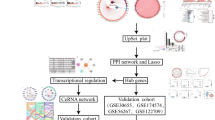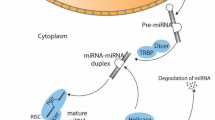Abstract
Epigenetic modification may play an important role in pathophysiology of ischemic stroke (IS) risk. MicroRNAs (miRNAs), which constitute one of the modes of epigenetic regulation, have been shown to be associated with a number of clinical disorders including IS. The purpose of this study was to investigate the miRNA profile in the peripheral blood mononuclear cells (PBMCs) of IS patients and compare it with stroke-free controls. Blood samples were obtained from 19 healthy age-gender-race matched individuals who served as controls to 20 IS patients. miRNA microarray analysis with RNA from PBMCs was performed and significantly dysregulated miRNAs common among IS patients were identified. We identified 117 miRNAs with linear fold values of at least ±1.5, of which, 29 were significantly altered (p value <0.05). Ingenuity Pathway Analysis (IPA) indicated a role for the dysregulated miRNAs in conditions relevant to IS (e.g., organismal injury and abnormalities, hematological disease and immunological disease). Pro-inflammatory genes like STAT3, interleukin (IL) 12A, and IL12B were some of the highly predicted targets for the dysregulated miRNAs. Notably, we further identified three common and significantly upregulated miRNAs (hsa-miR-4656, -432, -503) and one downregulated miRNA (hsa-miR-874) among all IS patients. Molecular interactive network analysis revealed that the commonly dysregulated miRNAs share several targets with roles relevant to IS. Altogether, we report dysregulation of miRNAs in IS PBMCs and provide evidence for their involvement in the immune system alteration during IS pathophysiology.





Similar content being viewed by others
References
Feigin VL, Krishnamurthi R (2010) Public health strategies could reduce the global stroke epidemic. Lancet Neurol 9(9):847–848. doi:10.1016/S1474-4422(10)70190-3
NINDS Brain basics: preventing stroke. National Institutes of Neurological Disorders and Stroke http:www.ninds.nih.gov/disorders/stroke/preventing_stroke.htm
Faber JE, Zhang H, Lassance-Soares RM, Prabhakar P, Najafi AH, Burnett MS, Epstein SE (2011) Aging causes collateral rarefaction and increased severity of ischemic injury in multiple tissues. Arterioscler Thromb Vasc Biol 31(8):1748–1756. doi:10.1161/ATVBAHA.111.227314
D'Agostino RB, Wolf PA, Belanger AJ, Kannel WB (1994) Stroke risk profile: adjustment for antihypertensive medication. The Framingham study. Stroke 25(1):40–43
Krupinski J, Slevin M (2013) Emerging molecular targets for brain repair after stroke. Stroke Res Treat 2013:473416. doi:10.1155/2013/473416
Ambros V (2004) The functions of animal microRNAs. Nature 431(7006):350–355. doi:10.1038/nature02871
Bartel DP (2004) MicroRNAs: genomics, biogenesis, mechanism, and function. Cell 116(2):281–297
Bartel DP (2009) MicroRNAs: target recognition and regulatory functions. Cell 136(2):215–233. doi:10.1016/j.cell.2009.01.002
Fabian MR, Sonenberg N, Filipowicz W (2010) Regulation of mRNA translation and stability by microRNAs. Annu Rev Biochem 79:351–379. doi:10.1146/annurev-biochem-060308-103103
Mraz M, Pospisilova S (2012) MicroRNAs in chronic lymphocytic leukemia: from causality to associations and back. Expert Rev Hematol 5(6):579–581. doi:10.1586/ehm.12.54
He L, Thomson JM, Hemann MT, Hernando-Monge E, Mu D, Goodson S, Powers S, Cordon-Cardo C et al (2005) A microRNA polycistron as a potential human oncogene. Nature 435(7043):828–833. doi:10.1038/nature03552
Mraz M, Pospisilova S, Malinova K, Slapak I, Mayer J (2009) MicroRNAs in chronic lymphocytic leukemia pathogenesis and disease subtypes. Leuk Lymphoma 50(3):506–509. doi:10.1080/10428190902763517
Cui JW, Li YJ, Sarkar A, Brown J, Tan YH, Premyslova M, Michaud C, Iscove N et al (2007) Retroviral insertional activation of the Fli-3 locus in erythroleukemias encoding a cluster of microRNAs that convert Epo-induced differentiation to proliferation. Blood 110(7):2631–2640. doi:10.1182/blood-2006-10-053850
Zhang HD, Jiang LH, Sun DW, Li J, Tang JH (2015) MiR-139-5p: promising biomarker for cancer. Tumour Biol 36(3):1355–1365. doi:10.1007/s13277-015-3199-3
Khoury S, Tran N (2015) Circulating microRNAs: potential biomarkers for common malignancies. Biomark Med 9(2):131–151. doi:10.2217/bmm.14.102
Guess MG, Barthel KK, Harrison BC, Leinwand LA (2015) miR-30 family microRNAs regulate myogenic differentiation and provide negative feedback on the microRNA pathway. PLoS One 10(2):e0118229. doi:10.1371/journal.pone.0118229
Zhuang LP, Meng ZQ (2015) Serum miR-224 reflects stage of hepatocellular carcinoma and predicts survival. Biomed Res Int 2015:731781. doi:10.1155/2015/731781
Ravo M, Cordella A, Rinaldi A, Bruno G, Alexandrova E, Saggese P, Nassa G, Giurato G et al (2015) Small non-coding RNA deregulation in endometrial carcinogenesis. Oncotarget 6(7):4677–4691. doi:10.18632/oncotarget.2911
Li M, Wang Y, Song Y, Bu R, Yin B, Fei X, Guo Q, Wu B (2015) MicroRNAs in renal cell carcinoma: a systematic review of clinical implications (review). Oncol Rep 33(4):1571–1578. doi:10.3892/or.2015.3799
Li P, Teng F, Gao F, Zhang M, Wu J, Zhang C (2015) Identification of circulating microRNAs as potential biomarkers for detecting acute ischemic stroke. Cell Mol Neurobiol 35(3):433–447. doi:10.1007/s10571-014-0139-5
Wang W, Sun G, Zhang L, Shi L, Zeng Y (2014) Circulating microRNAs as novel potential biomarkers for early diagnosis of acute stroke in humans. J Stroke Cerebrovasc Dis 23(10):2607–2613. doi:10.1016/j.jstrokecerebrovasdis.2014.06.002
Sorensen SS, Nygaard AB, Nielsen MY, Jensen K, Christensen T (2014) miRNA expression profiles in cerebrospinal fluid and blood of patients with acute ischemic stroke. Transl Stroke Res 5(6):711–718. doi:10.1007/s12975-014-0364-8
Zhou J, Zhang J (2014) Identification of miRNA-21 and miRNA-24 in plasma as potential early stage markers of acute cerebral infarction. Mol Med Rep 10(2):971–976. doi:10.3892/mmr.2014.2245
Leung LY, Chan CP, Leung YK, Jiang HL, Abrigo JM, Wang de F, Chung JS, Rainer TH et al (2014) Comparison of miR-124-3p and miR-16 for early diagnosis of hemorrhagic and ischemic stroke. Clin Chim Acta 433:139–144. doi:10.1016/j.cca.2014.03.007
Sepramaniam S, Tan JR, Tan KS, DeSilva DA, Tavintharan S, Woon FP, Wang CW, Yong FL et al (2014) Circulating microRNAs as biomarkers of acute stroke. Int J Mol Sci 15(1):1418–1432. doi:10.3390/ijms15011418
Long G, Wang F, Li H, Yin Z, Sandip C, Lou Y, Wang Y, Chen C et al (2013) Circulating miR-30a, miR-126 and let-7b as biomarker for ischemic stroke in humans. BMC Neurol 13:178. doi:10.1186/1471-2377-13-178
Li WY, Jin J, Chen J, Guo Y, Tang J, Tan S (2014) Circulating microRNAs as potential non-invasive biomarkers for the early detection of hypertension-related stroke. J Hum Hypertens 28(5):288–291. doi:10.1038/jhh.2013.94
Tsai PC, Liao YC, Wang YS, Lin HF, Lin RT, Juo SH (2013) Serum microRNA-21 and microRNA-221 as potential biomarkers for cerebrovascular disease. J Vasc Res 50(4):346–354. doi:10.1159/000351767
Jickling GC, Ander BP, Zhan X, Noblett D, Stamova B, Liu D (2014) microRNA expression in peripheral blood cells following acute ischemic stroke and their predicted gene targets. PLoS One 9(6):e99283. doi:10.1371/journal.pone.0099283
Wang Y, Zhang Y, Huang J, Chen X, Gu X, Zeng L, Yang GY (2014) Increase of circulating miR-223 and insulin-like growth factor-1 is associated with the pathogenesis of acute ischemic stroke in patients. BMC Neurol 14:77. doi:10.1186/1471-2377-14-77
Moon JM, Xu L, Giffard RG (2013) Inhibition of microRNA-181 reduces forebrain ischemia-induced neuronal loss. J Cereb Blood Flow Metab 33(12):1976–1982. doi:10.1038/jcbfm.2013.157
Yang Q, Yang K, Li A (2014) microRNA-21 protects against ischemia-reperfusion and hypoxia-reperfusion-induced cardiocyte apoptosis via the phosphatase and tensin homolog/Akt-dependent mechanism. Mol Med Rep 9(6):2213–2220. doi:10.3892/mmr.2014.2068
Selvamani A, Williams MH, Miranda RC, Sohrabji F (2014) Circulating miRNA profiles provide a biomarker for severity of stroke outcomes associated with age and sex in a rat model. Clin Sci (Lond) 127(2):77–89. doi:10.1042/CS20130565
Lee ST, Chu K, Jung KH, Yoon HJ, Jeon D, Kang KM, Park KH, Bae EK et al (2010) MicroRNAs induced during ischemic preconditioning. Stroke 41(8):1646–1651. doi:10.1161/STROKEAHA.110.579649
Zeng L, Liu J, Wang Y, Wang L, Weng S, Tang Y, Zheng C, Cheng Q et al (2011) MicroRNA-210 as a novel blood biomarker in acute cerebral ischemia. Front Biosci (Elite Ed) 3:1265–1272
Kassner SS, Kollmar R, Bonaterra GA, Hildebrandt W, Schwab S, Kinscherf R (2009) The early immunological response to acute ischemic stroke: differential gene expression in subpopulations of mononuclear cells. Neuroscience 160(2):394–401. doi:10.1016/j.neuroscience.2009.02.050
Grond-Ginsbach C, Hummel M, Wiest T, Horstmann S, Pfleger K, Hergenhahn M, Hollstein M, Mansmann U et al (2008) Gene expression in human peripheral blood mononuclear cells upon acute ischemic stroke. J Neurol 255(5):723–731. doi:10.1007/s00415-008-0784-z
Mi H, Thomas P (2009) PANTHER pathway: an ontology-based pathway database coupled with data analysis tools. Methods Mol Biol 563:123–140. doi:10.1007/978-1-60761-175-2_7
Shannon P, Markiel A, Ozier O, Baliga NS, Wang JT, Ramage D, Amin N, Schwikowski B et al (2003) Cytoscape: a software environment for integrated models of biomolecular interaction networks. Genome Res 13(11):2498–2504. doi:10.1101/gr.1239303
Adams HP Jr, Bendixen BH, Kappelle LJ, Biller J, Love BB, Gordon DL, Marsh EE 3rd (1993) Classification of subtype of acute ischemic stroke. Definitions for use in a multicenter clinical trial. TOAST. Trial of Org 10172 in Acute Stroke Treatment. Stroke 24(1):35–41
Hutchins AP, Diez D, Miranda-Saavedra D (2013) Genomic and computational approaches to dissect the mechanisms of STAT3’s universal and cell type-specific functions. JAKSTAT 2(4):e25097. doi:10.4161/jkst.25097
Braun DA, Fribourg M, Sealfon SC (2013) Cytokine response is determined by duration of receptor and signal transducers and activators of transcription 3 (STAT3) activation. J Biol Chem 288(5):2986–2993. doi:10.1074/jbc.M112.386573
Zaremba J, Losy J (2006) Interleukin-12 in acute ischemic stroke patients. Folia Neuropathol 44(1):59–66
Kochanek PM, Hallenbeck JM (1992) Polymorphonuclear leukocytes and monocytes/macrophages in the pathogenesis of cerebral ischemia and stroke. Stroke 23(9):1367–1379
Muir KW, Tyrrell P, Sattar N, Warburton E (2007) Inflammation and ischaemic stroke. Curr Opin Neurol 20(3):334–342. doi:10.1097/WCO.0b013e32813ba151
Kawabori M, Yenari MA (2015) Inflammatory responses in brain ischemia. Curr Med Chem 22(10):1258–1277
Pei J, You X, Fu Q (2015) Inflammation in the pathogenesis of ischemic stroke. Front Biosci (Landmark Ed) 20:772–783
Gesuete R, Kohama SG, Stenzel-Poore MP (2014) Toll-like receptors and ischemic brain injury. J Neuropathol Exp Neurol 73(5):378–386. doi:10.1097/NEN.0000000000000068
Welten SM, Bastiaansen AJ, de Jong RC, de Vries MR, Peters EA, Boonstra MC, Sheikh SP, La Monica N et al (2014) Inhibition of 14q32 MicroRNAs miR-329, miR-487b, miR-494, and miR-495 increases neovascularization and blood flow recovery after ischemia. Circ Res 115(8):696–708. doi:10.1161/CIRCRESAHA.114.304747
CDC (2002) Centers for Disease Control and Prevention: state-specific mortality from stroke and distrbution of place of death—United States, 1999. MMWR Morb Mortal Wkly Rep 51:429–433
Chikuma S, Suita N, Okazaki IM, Shibayama S, Honjo T (2012) TRIM28 prevents autoinflammatory T cell development in vivo. Nat Immunol 13(6):596–603. doi:10.1038/ni.2293
How Cardiovascular & Stroke Risks Relate. http://www.strokeassociation.org/STROKEORG/LifeAfterStroke/HealthyLivingAfterStroke/UnderstandingRiskyConditions/How-Cardiovascular-Stroke-Risks-Relate_UCM_310369_Article.jsp
Yang L, Xiong Y, Hu XF, Du YH (2015) MicroRNA-323 regulates ischemia/reperfusion injury-induced neuronal cell death by targeting BRI3. Int J Clin Exp Pathol 8(9):10725–10733 eCollection 2015
Acknowledgements
This study is supported in part by the SC Smart State Funds, National Institutes of Health grants P01AT003961, R01AT006888, R01ES019313, R01MH094755, AI29788, and P20GM103641 to PN and MN.
Author information
Authors and Affiliations
Corresponding author
Ethics declarations
Conflict of Interest
The authors declare that they have no conflict of interest.
Ethical Approval
All procedures performed in studies involving human participants were approved by the Institutional Review Board of the University of South Carolina and obtained written consent from all participants/subjects.
Electronic Supplementary Material
.
ESM 1
(PDF 715 kb)
Rights and permissions
About this article
Cite this article
Bam, M., Yang, X., Sen, S. et al. Characterization of Dysregulated miRNA in Peripheral Blood Mononuclear Cells from Ischemic Stroke Patients. Mol Neurobiol 55, 1419–1429 (2018). https://doi.org/10.1007/s12035-016-0347-8
Received:
Accepted:
Published:
Issue Date:
DOI: https://doi.org/10.1007/s12035-016-0347-8




